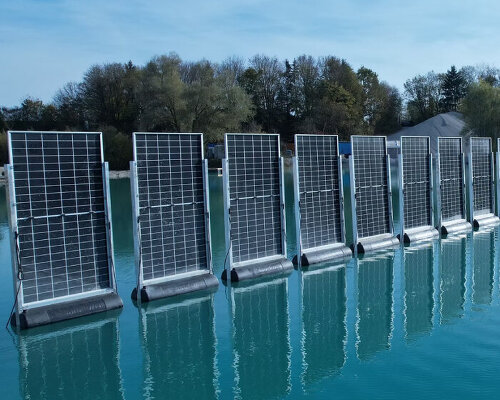floating vertical solar panels stand on hollow plastic barrels
SINN Power creates floating vertical solar panels named SKipp to harness the energy from sunlight directly on ponds, lakes, fish farms, lagoons, and other water bodies. Recently, the team has produced and planted a series of solar panels in a gravel pond in Bavaria, Germany, specifically in Gilching, near Munich. The company says that the project can produce an energy output that meets around 70 percent of the gravel plant’s annual electricity demand, making the operation mostly self-sufficient in energy. The floating vertical solar panels can help reduce carbon dioxide emissions by about 934 tons per year, as the company claims. The structure of the system is based on floating photovoltaic modules. These solar panels are mounted vertically on hollow plastic barrels that allow them to float on the pond and to tilt back and forth without actually falling.
When wind pressure increases, the modules can tilt backward and then return to their original position when the wind drops. The design makes sure that the structure is away from any mechanical stress and damage while keeping the modules stable on the water. The flexible motion also helps manage the system during harsh weather conditions. Anchoring is done on the shore, making the project modular, too. The vertical orientation also means that snow can slide off naturally, preventing buildup that could block sunlight. Each SKipp unit has bifacial modules, which generate power from both sides of the solar panel: the front captures direct sunlight, while the back collects reflected light from the water surface, allowing for sunlight harnessing regardless of the rays’ positions.
all images courtesy of SINN Power
modular structures absorb sunlight from water bodies
The floating vertical solar panels by SINN Power fall under the company’s SKipp system, which is a product family of modular and tiltable photovoltaic modules. Unlike traditional solar-power structures, these modules are designed to perform on rooftops, water bodies, or other difficult locations where traditional fixed solar systems are not suitable. The panels are mounted vertically and can deflect under wind pressure, and they can also expand or shrink based on project size and energy needs. The design also supports fast installation and easy replacement of individual parts, and the system’s construction allows for up to 30 percent more modules to be installed compared to standard floating or land-based systems, which can improve the total energy output per site.
The design follows a 15 percent water coverage regulation, which means that most of the water surface is still open. Thanks to this setup, the panels don’t affect the water ecology and keep the installation suitable even for smaller bodies of water. The open structure also allows sunlight and oxygen to reach the water. The materials used in the floating system include plastic floats, metal frames, and photovoltaic glass modules. The plastic floats are sealed to remain buoyant over time, while the frames are corrosion-resistant to handle constant contact with moisture. The panels are made of layered glass and silicon cells, and they can withstand exposure to sun, wind, and water vapor. At the present time, the company has installed the floating vertical solar panels in a couple of cities around Germany.
floating vertical solar panels harness the energy from sunlight directly on water bodies
recently, the team has produced and planted a series of solar panels in a gravel pond in Bavaria, Germany
the structures stand on hollow plastic barrels
the materials used in the floating system include plastic floats, metal frames, and photovoltaic glass modules
the plastic floats are sealed to remain buoyant over time
the panels are made of layered glass and silicon cells
project info:
name: SKipp
company: SINN Power | @sinnpower
The post floating vertical solar panels capture sun’s energy from ponds, lakes, fish farms and lagoons appeared first on designboom | architecture & design magazine.

